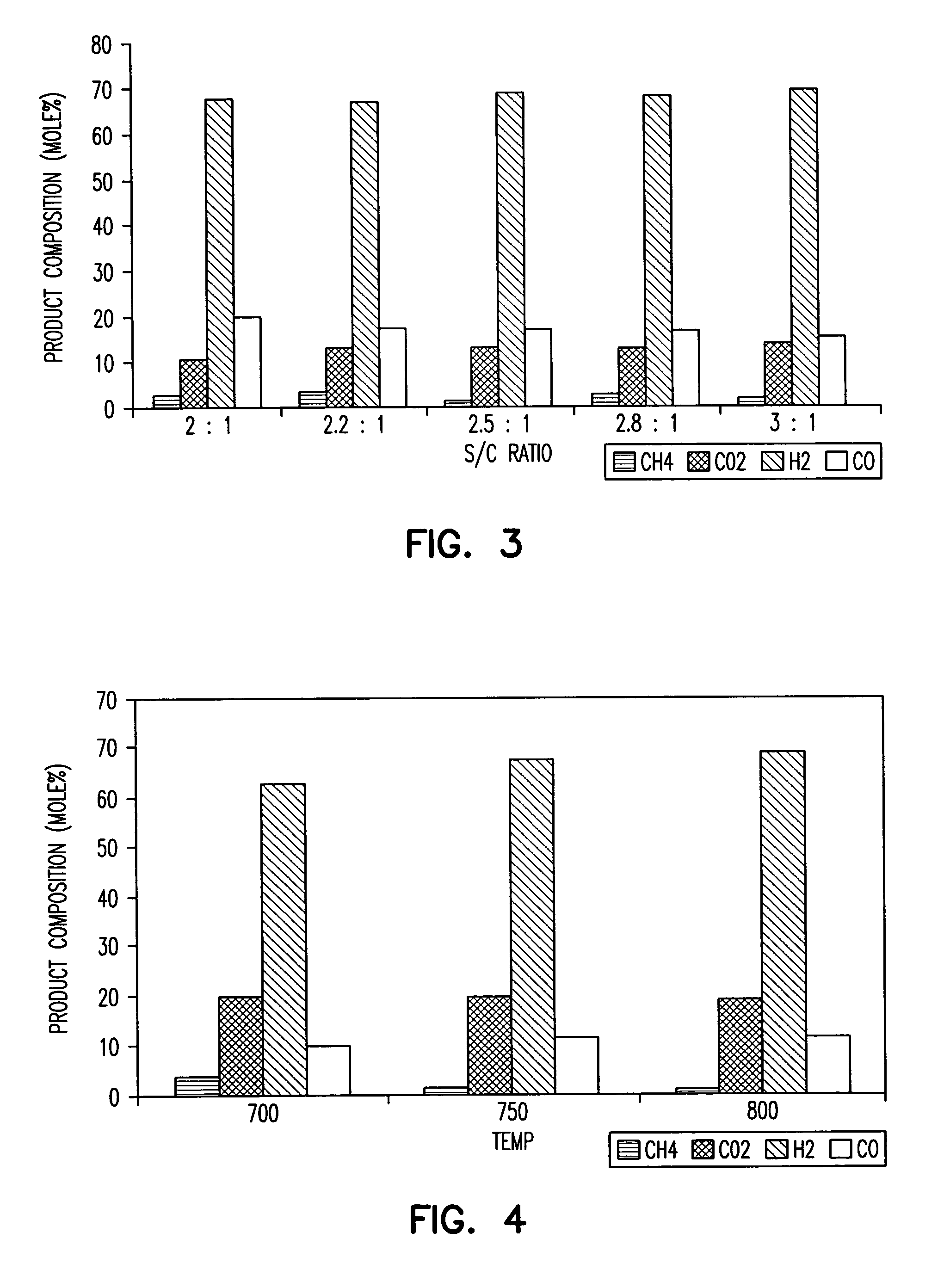Sulfur-tolerant catalysts and related precursors and processes
- Summary
- Abstract
- Description
- Claims
- Application Information
AI Technical Summary
Benefits of technology
Problems solved by technology
Method used
Image
Examples
example 2
Preparation of Catalyst Precursors
[0083] To prepare around 22 g of Ni--V.sub.2O.sub.5--ZrO.sub.2 / Al.sub.2O.s-ub.3 catalyst precursor containing 10% Ni, 9.91 g of NiNO.sub.3.6H.sub.2O is dissolved in THF and acidified with HNO.sub.3 (pH=0.2 to 0.4) and stirred overnight. To this is added 20 g of V.sub.2O.sub.5--ZrO.sub.2 / Al.-sub.2O.sub.3 that has been treated in vacuum overnight at 10.degree. C. After stirring for 24 hours, the solvent is removed by evaporation in air. It is then dried in an oven at 110.degree. C. for 4 hours and then calcined at 600.degree. C.
[0084] For catalysts comprised of Pd, Pt or Rh alone, at least around 1% by weight of such transition metals should typically be used. For catalysts containing Ni in combination with other transition metals, mixtures of 10% elemental Ni with at least 1% of one or more of the other elemental transition metals should be preferred. For 1 g of V.sub.2O.sub.5--ZrO.sub.2 / Al.sub.2O.sub.3 catalyst containing 1% Pt, around 0.021 g of pl...
example 3
Catalyst Screening
(a) Ni--V.sub.2O.sub.5--ZrO.sub.2 / Al.sub.2O.sub.3 Catalysts
[0085] In this and the following examples, all catalysts tested or described were, or would be, in the form of 40-60 mesh particles unless otherwise noted. Reactant feed was controlled with mass flow controllers or syringe pumps. The product stream was analyzed using gas chromatography.
[0086] Ni--V.sub.2O.sub.5--ZrO.sub.2 / Al.sub.2O.sub.3 catalysts, prepared from catalyst precursors and characterized as described in Examples 1 and 2 were screened by measuring catalytic activities using an integral packed bed reactor. The catalyst support alumina was also tested as were compositions containing only one of Ni, Pd, Pt, Ru or Rh supported on alumina. While these were catalytically active initially, they deactivated quickly during testing. Similarly, catalyst compositions comprising an elemental transition group metal, e.g., Ni, Pd, Pt, Ru or Rh supported on inert supports such as alumina were tested and were cat...
example 4
Catalysts with Other Metals
[0088] Catalysts containing 1% Pd, Pt, Ru, and Rh, supported on V.sub.2O.sub.5--ZrO.sub.2 / Al.sub.2O.sub.3 were also studied. Their oxides, generated by calcining the impregnated precursors, are all easily reducible (typically done at 350.degree. C. for ten hours under hydrogen flow). When these metals are supported on alumina (without the presence of the oxides of vanadium and zirconium) the catalysts exhibit high initial activity and selectivity toward H.sub.2 in steam reforming of isooctane, but generally deactivated quickly due to formation of coke on their surface. Increasing the amount of such transition metals to 10% by weight should yield catalysts with a prolonged activity just as was observed when nickel content was increased from 1% to 10%.
PUM
| Property | Measurement | Unit |
|---|---|---|
| Fraction | aaaaa | aaaaa |
| Fraction | aaaaa | aaaaa |
| Fraction | aaaaa | aaaaa |
Abstract
Description
Claims
Application Information
 Login to View More
Login to View More - R&D
- Intellectual Property
- Life Sciences
- Materials
- Tech Scout
- Unparalleled Data Quality
- Higher Quality Content
- 60% Fewer Hallucinations
Browse by: Latest US Patents, China's latest patents, Technical Efficacy Thesaurus, Application Domain, Technology Topic, Popular Technical Reports.
© 2025 PatSnap. All rights reserved.Legal|Privacy policy|Modern Slavery Act Transparency Statement|Sitemap|About US| Contact US: help@patsnap.com


